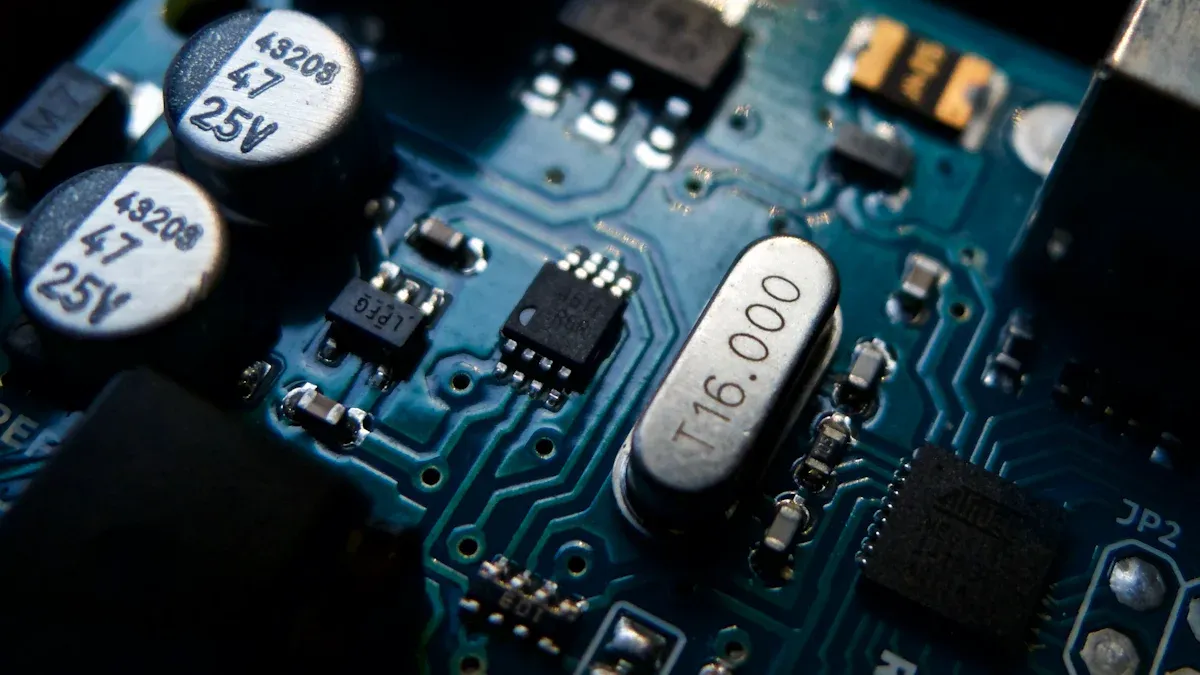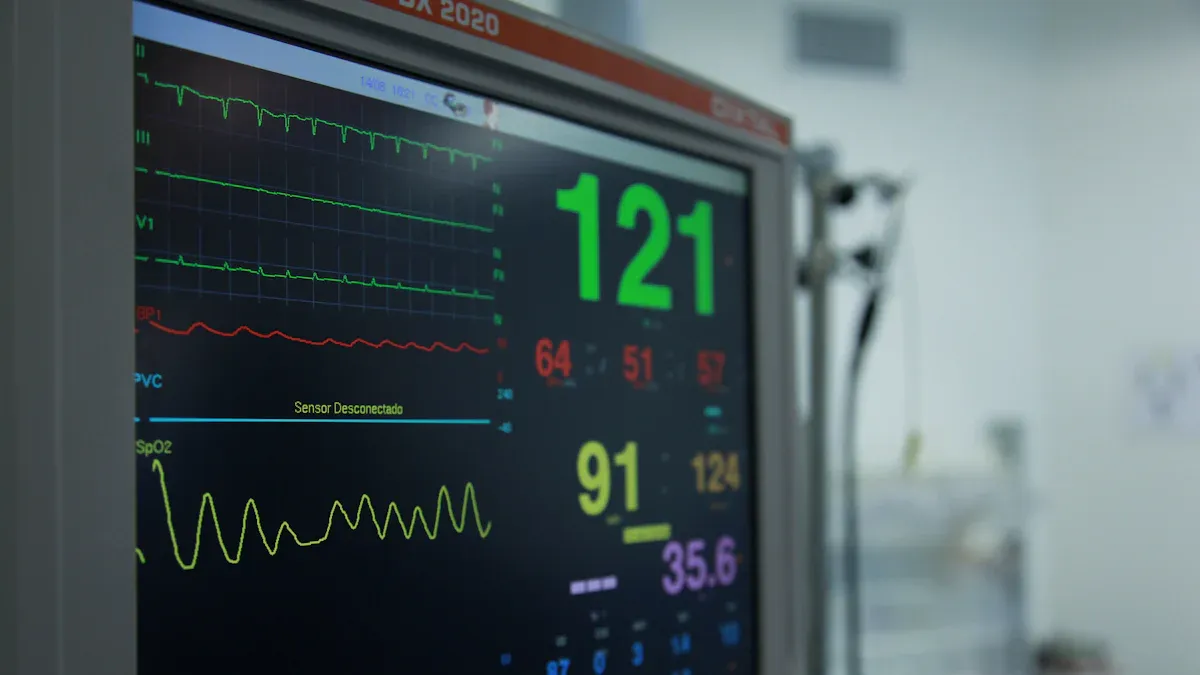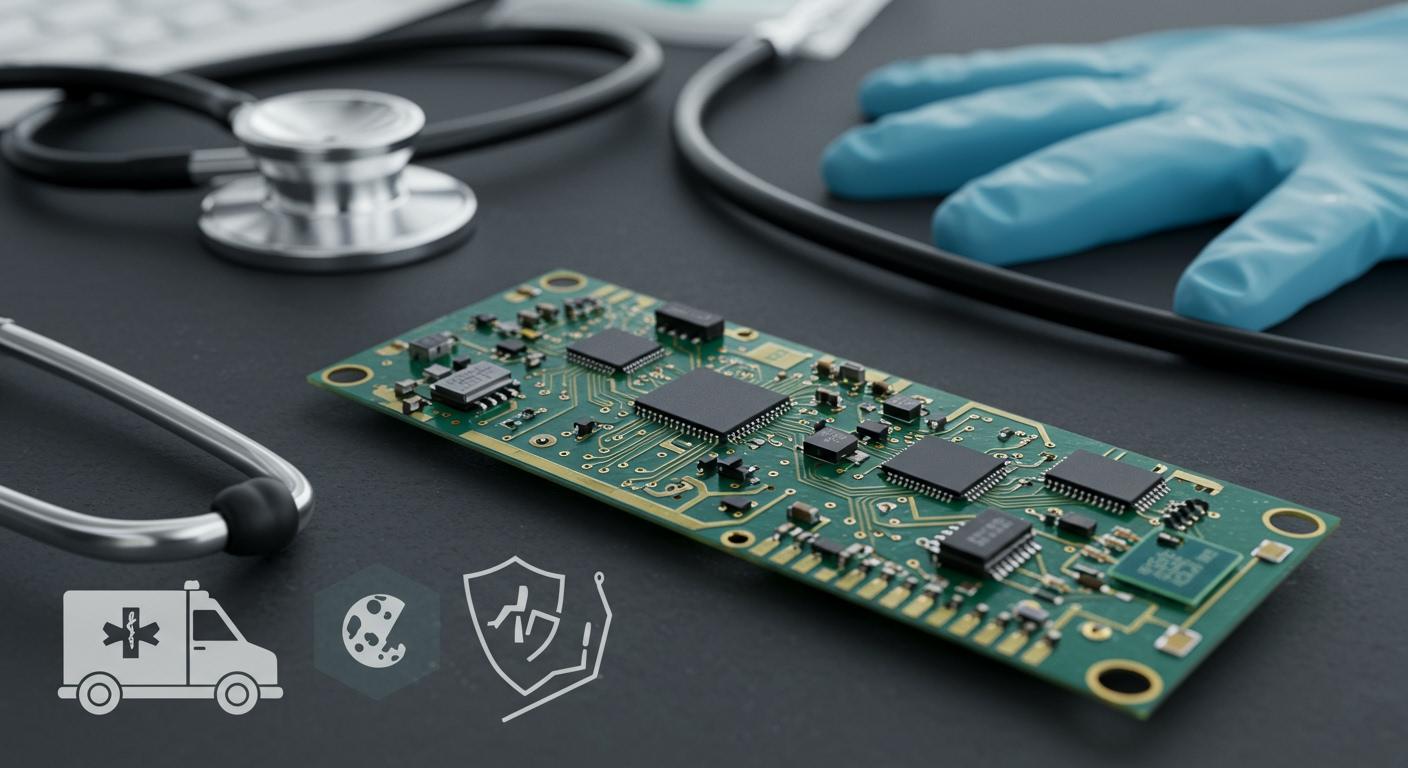You face mounting pressure to meet strict safety standards in medical EMS FPC PCB applications. Medical devices now involve advanced technology and complex compliance challenges, including legal language, registration, and product-level intricacies.
| Aspect | Description |
|---|---|
| Regulatory Landscape | Increased complexity due to EU MDR and ISO 13485:2016 harmonization. |
| Compliance Challenges | Companies struggle with understanding and complying with regulations across multiple markets. |
| Impact on Innovation | Heightened regulatory challenges weaken the innovation process and affect market access. |
Non-compliance in medical PCB manufacturing can lead to patient harm, costly recalls, and industry reputation damage.
Key Takeaways
- Prioritize patient safety by ensuring every medical PCB meets strict quality standards. Rigorous testing and documentation are essential to prevent malfunctions that could harm patients.
- Understand the critical role of certifications like ISO 13485 and IEC 60601. These certifications ensure compliance with safety regulations and enhance your reputation in the medical industry.
- Stay informed about evolving regulatory standards. Keeping up with changes helps you maintain market access and protect patients from potential risks associated with non-compliance.
- Choose certified partners for medical PCB assembly. Working with reliable suppliers ensures that your products meet safety and quality standards, reducing the risk of recalls and legal issues.
- Implement a robust quality assurance strategy. Regular testing and documentation throughout the manufacturing process support compliance and enhance the reliability of your medical devices.
Medical PCB Risks

Patient Safety
You must prioritize patient safety when designing and manufacturing medical pcbs. Medical devices rely on high-reliability pcbs to deliver accurate performance in critical medical applications. If a medical circuit board fails, patients can experience serious harm. Electrical malfunctions, component failures, and poor biocompatibility can disrupt medical devices during surgery or monitoring. You need to ensure every medical pcb meets strict standards for quality and reliability. Regulatory agencies require risk management processes to identify and mitigate these threats. Post-market surveillance helps you monitor medical devices after release, allowing you to address safety issues quickly. Consistent product quality in the medical pcb industry protects patients and supports trust in medical applications.
Patient safety depends on your commitment to rigorous testing and documentation for every medical circuit board.
Legal and Reputational Issues
You face significant legal and reputational risks if you overlook compliance in the medical pcb industry. Regulatory bodies such as the FDA demand that medical pcbs meet strict documentation and labeling requirements. Without proper certification, you cannot legally market or sell medical devices. Recalls and lawsuits can damage your reputation and result in financial losses. The medical pcb industry expects you to maintain ISO 13485 certification and follow international standards. Failure to comply with these regulations can prevent your medical devices from reaching the market. High-performance medical pcbs must meet all legal requirements to protect your business and reputation.
| Risk Factor | Impact on Your Organization |
|---|---|
| Regulatory Non-Compliance | Product recalls, fines, market exclusion |
| Poor Documentation | Legal disputes, loss of trust |
| Inadequate Surveillance | Missed safety issues, reputational harm |
You must treat compliance as a core part of your strategy in medical applications. This approach ensures your medical circuit boards meet industry expectations and legal standards.
Medical EMS FPC PCB Certifications
You must understand the critical role of certifications in medical ems fpc pcb manufacturing. These certifications set the foundation for safety, reliability, and compliance in every medical pcb you produce. Each standard addresses unique aspects of quality management, risk reduction, and environmental responsibility. Let’s break down the most important certifications you need to know.
ISO 13485
ISO 13485 stands as the cornerstone for quality management in medical pcb manufacturing. This certification requires you to maintain strict documentation, traceability, and auditability throughout your production process. You must document every step, identify defects, and record corrective actions. Traceability systems help you track all materials and components, which is essential for recalls and continuous improvement. Auditors will expect you to provide data on defects and traceability at any time.
When you achieve ISO 13485, you open doors to global markets, enhance your reputation, and reduce risks of defects or regulatory penalties. You also improve efficiency by minimizing errors and boosting productivity.
| Key Element | Description |
|---|---|
| Regulatory Compliance | You must identify and document all regulatory requirements for your products. |
| Risk Management | You need to document and manage risks associated with your medical pcb. |
| Feedback Handling | You must establish a robust process for customer feedback and complaints. |
ISO 13485 ensures that every stage of medical ems fpc pcb production meets strict quality controls. This is vital for devices like defibrillators, where even a minor defect can have serious consequences.
IEC 60601
IEC 60601-1 is the gold standard for electrical safety in medical devices. You must comply with this standard to ensure your medical pcb meets the highest safety requirements. IEC 60601-1 addresses electromagnetic compatibility, which is crucial for sensitive applications such as surgical robots. The standard provides test protocols that assess patient safety when using medical device electronics.
- IEC 60601-1 ensures your devices do not interfere with other equipment in a hospital environment.
- You must follow these protocols to protect patients from electrical hazards and ensure device reliability.
- Compliance with IEC 60601-1 demonstrates your commitment to patient safety and regulatory excellence.
IPC 6013 and UL 796
You need to meet both IPC 6013 and UL 796 standards when manufacturing flexible printed circuit boards for medical applications. IPC 6013 focuses on performance specifications for flexible printed wiring, ensuring your medical pcb remains reliable under various environmental conditions. UL 796 addresses the safety of rigid printed circuit boards, reducing fire and shock risks. For flexible circuits, UL 796F provides additional safety requirements tailored to their unique characteristics.
| Standard | Focus | Application in Medical FPCs |
|---|---|---|
| UL 796 | Safety of rigid printed circuit boards, reducing fire and shock risks | General safety requirements for flexible circuits |
| UL 796F | Specific to flexible printed circuits, addressing unique characteristics | Ensures safety tailored to flexible circuit designs |
| IPC 6013 | Performance specifications for flexible printed wiring applications | Focuses on reliability under varying environmental conditions |
By following these standards, you ensure your medical ems fpc pcb can withstand demanding conditions and deliver consistent performance.
ISO 9001, ISO 14001, IATF 16949
You should also consider broader certifications that support safety and environmental compliance in medical pcb manufacturing. ISO 9001 ensures you maintain quality management and process consistency, which enhances safety. ISO 14001 focuses on environmental responsibility, helping you minimize your impact on the environment. IATF 16949 emphasizes automotive-grade reliability, which is increasingly relevant for medical applications that demand high durability.
| Certification | Contribution to Safety and Environmental Compliance |
|---|---|
| ISO 9001 | Ensures quality management and consistency in processes, enhancing safety. |
| ISO 14001 | Focuses on environmental responsibility and minimizing impact. |
| IATF 16949 | Emphasizes automotive-grade reliability, relevant for medical applications. |
Many leading medical pcb manufacturers hold multiple certifications, such as ISO 13485 and ISO 9001, to demonstrate their commitment to quality and compliance.
When you choose a partner with these certifications, you protect your patients, your reputation, and your business.
Compliance in Medical PCBs
Regulatory Standards
You must navigate a complex landscape of regulations and standards when working with medical pcbs. International and local compliance requirements shape every step of your manufacturing process. You need to understand the most critical standards that govern medical devices and medical pcb production:
- ISO 9001 sets the foundation for quality management systems.
- ISO 13485 focuses on quality for medical pcbs in the medical industry.
- FDA regulations control medical devices in the United States.
- CE marking is essential for products sold in Europe.
- IEC 60601 defines electrical safety for medical devices.
You also need to meet IPC A-600, IPC A-610, and IPC A-6012 for acceptability and performance of printed boards and assemblies. In the United States, the EPA enforces regulations for medical pcb manufacturers, including new rules for PCB waste disposal in 2024. These standards and regulations ensure your medical devices meet strict safety and quality expectations.
You protect patients and your business by following compliance requirements for every medical pcb you produce.
Quality Assurance
You must treat quality assurance as a core part of your compliance strategy. Rigorous testing and documentation help you meet regulatory standards and prove the reliability of your medical devices. You need to perform testing at every stage, from raw materials to final assemblies. Quality checks confirm that your medical pcbs function safely in medical applications.
Compliance with regulations directly affects your ability to gain device approval and access major markets. The table below shows how regulatory standards shape the approval process for medical devices in the US and EU:
| Region | Approval Process | Key Requirements |
|---|---|---|
| EU | Decentralized; involves Notified Body | Compliance with EU medical device regulation, CE mark application |
| US | Centralized through FDA | Compliance with FDA regulations, ensuring safety and effectiveness |
You must maintain detailed records and testing results to satisfy compliance requirements. This approach supports your reputation in the medical industry and helps you deliver high-quality medical pcbs for critical applications.
Device Safety and Reliability

Patient Protection
You play a crucial role in protecting patients when you focus on the reliability of medical devices. Every medical pcb you use must deliver consistent performance in life-critical situations. Medical devices often operate in demanding environments, so you cannot afford failures. If a medical pcb malfunctions, patient health and safety are at risk. You need to select components that meet strict reliability standards. Testing each pcb for defects helps you prevent dangerous errors in medical applications.
Reliable medical pcbs give you confidence that your technology will support patient care without unexpected interruptions.
You should always document your quality checks. This process allows you to trace issues quickly and take corrective action. In the medical industry, you must prove that your devices meet safety requirements before they reach the market. Patients depend on your commitment to reliability every time they use medical devices.
Product Longevity
You must consider product longevity when designing medical devices. Reliable medical pcbs extend the lifespan of your equipment and reduce maintenance costs. When you choose high-quality materials, you improve the durability of your technology. This approach helps you avoid frequent repairs and replacements.
- Longer-lasting medical devices increase trust in your brand.
- Fewer breakdowns mean less downtime for critical medical equipment.
- Consistent reliability supports better patient outcomes.
A focus on reliability also helps you meet industry regulations. You can demonstrate that your medical devices will perform safely over time. In the competitive medical field, product longevity sets you apart and ensures your solutions remain effective in real-world applications.
Medical PCB Assembly: Choosing Certified Partners
Certification Checklist
You need a clear checklist when selecting partners for medical pcb assembly. Certified partners help you meet strict safety and quality standards for medical devices. Use the following table to guide your selection process:
| Certification | Purpose & Relevance |
|---|---|
| ISO 9001:2015 | Ensures a strong quality management system for consistent product quality and customer satisfaction. |
| IATF 16949 | Focuses on defect prevention and continuous improvement, important for high-reliability electronics. |
| UL Certification | Confirms compliance with safety standards, such as fire resistance and electrical insulation. |
| ISO 13485:2016 | Mandatory for medical pcb assembly; ensures strict quality and traceability for patient safety. |
You should also look for these additional requirements:
- RoHS compliance to restrict hazardous materials in your medical pcb.
- IPC-A-610 standards for visual quality and assembly consistency.
- ISO 14001 for environmental responsibility in your medical pcb assembly process.
A certified partner gives you confidence that your medical pcbs will meet global regulatory demands and protect patient safety.
Supplier Evaluation
You must evaluate each supplier’s compliance and reliability before starting any medical pcb assembly project. Start by checking if the supplier trains teams on IPC standards and uses high-quality materials that meet IPC specifications. Reliable suppliers implement rigorous inspection processes to catch defects early in medical pcbs.
Follow these best practices:
- Work only with certified manufacturers who follow ISO 13485 and ISO 9001.
- Ensure the supplier uses comprehensive testing protocols, including functional, electrical, and environmental tests for every medical pcb.
- Review their inspection plans and risk assessment methods.
- Ask about their feedback systems for continuous improvement in medical pcb assembly.
- Check if they use reliable components and maintain detailed documentation for traceability.
Leading companies also perform DFM checks, BOM reviews, and stack-up analysis to ensure the reliability of medical pcb assembly. You should expect suppliers to offer thermal, environmental, and signal integrity testing for your medical pcbs.
Choosing the right partner for medical pcb assembly protects your brand, supports compliance, and ensures long-term device reliability.
Why Certification Matters Now
Industry Trends
You see rapid changes in the medical industry that make certification more important than ever. Medical devices now require you to meet evolving standards for safety, reliability, and environmental responsibility. Over the past five years, regulatory bodies have introduced new rules that demand higher quality controls and global harmonization. You must keep up with these changes to protect patients and maintain market access.
| Year | Regulatory Changes | Description |
|---|---|---|
| 2024 | Increased Complexity | Evolving requirements across regions and tighter quality controls. |
| 2025+ | Sustainability Regulations | Stricter environmental standards and recyclable PCB materials. |
| 2025+ | Global Harmonization | Alignment between FDA, EU MDR, and ISO standards. |
| 2025+ | AI-Driven Compliance | Automated compliance monitoring using AI. |
| 2025+ | Cybersecurity Integration | Mandatory hardware-based encryption for connected medical PCBs. |
| 2025+ | Patient-Centric Validation | Requirement for real-world monitoring data for PCB reliability. |
You must invest in regulatory intelligence to keep up with updates. The medical industry expects you to deliver medical devices that meet stringent standards for safety and effectiveness. You face growing demand for consistency and reliability in medical pcbs. Manufacturers who adapt quickly gain a competitive edge in medical applications.
You protect your business and patients by staying ahead of regulatory trends and prioritizing certification for every medical pcb.
Recent Incidents
You cannot ignore the consequences of using uncertified medical pcbs in medical devices. Recent recalls highlight the risks to patient safety and business reputation. Fresenius Medical Care faced criticism from the FDA after a delayed response to PCB contamination in dialysis machines. The FDA issued a Class I recall for about 2.2 million devices due to potential exposure to toxic compounds. The recall focused on the risk of chemical leakage from silicone tubing, which could lead to serious health issues such as liver problems and neurobehavioral changes.
- The FDA warned that exposure to NDL-PCBs could harm patients, especially those under 40 kg.
- Fresenius Medical Care switched to safer silicone tubing to prevent future risks.
- Healthcare professionals received guidance on how to mitigate risks for patients using affected devices.
You must learn from these incidents. Delayed corrective actions and lack of certification can result in recalls, regulatory penalties, and loss of trust. You need to choose certified partners and maintain strict quality controls for every medical pcb in your medical devices.
Certification is not optional. You safeguard patient health and your reputation by making safety and compliance your top priorities.
You cannot compromise on safety when it comes to medical ems fpc pcb. Patient protection, compliance, and product reliability all depend on your commitment to high standards in medical device manufacturing. Regularly verifying supplier certifications helps you maintain medical quality and reduce risk:
- You ensure compliance with regulatory standards for every medical ems fpc pcb.
- You focus resources on high-risk suppliers for better oversight.
- You identify early warning signs and take action before problems escalate.
To strengthen your medical supply chain, follow these steps:
- Plan carefully during the design stage to avoid shortages.
- Use third-party software to monitor medical components.
- Consider last-time buys for critical medical parts.
- Choose ECM vendors with medical lifecycle expertise.
- Ensure your PCB supplier meets ISO 13485 for medical standards.
Review your supply chain today. Prioritize certified partners to protect your patients and your reputation in the medical industry.










 2025-10-10
2025-10-10
 BEST
BEST


.png)
.png)
.png)
.png)

.png)

